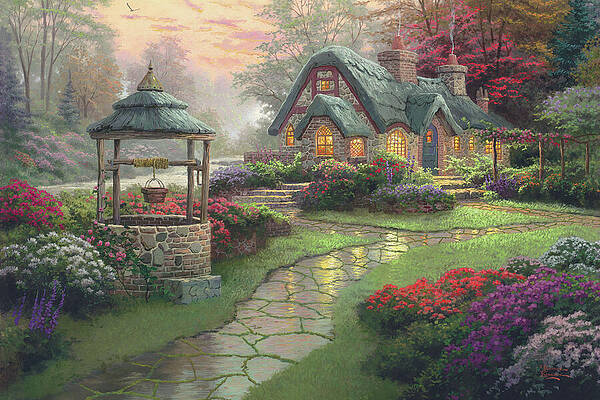Art For Everybody

Yesterday I posted against aesthetic snobbery in general, but what about art that has noxious political and social effects, as opposed to merely offending one’s sense of taste? The always interesting Sarah Jones has an essay on Thomas Kinkade, and the recent documentary about him, Art For Everybody:
Kinkade’s most famous subject was the humble cottage, lit from within by unsettling candlelight. Former Evangelicals may also recall the Bridge of Hope, which spans a creek and heads nowhere. A white dogwood tree stands nearby, a “symbol of the purity of God’s grace,” according to the Kinkade company’s website. Kinkade created a world that some people, maybe even millions of people, wanted to inhabit. Though he was a Christian and his work often contained religious imagery, his art did not proselytize so much as it advertised an alternative reality where proselytization was no longer necessary. In Kinkade-land, everything is serene. There is cohesion. Grandmothers love his pink skies and cobblestone paths. Even today I can close my eyes and imagine a Kinkade abode, squatting underneath some eldritch sunset. A Kinkade landscape is often lifeless. There are few human beings, and fewer complications. Sometimes Jesus appears; other times he is more of a suggestion. . .
The same people who made Kinkade a millionaire helped make Donald Trump a two-time president, and Art for Everybody arrives in a moment shaped by authoritarian tastes. Kinkade’s variations on kitsch merely hinted at a world of Christian dominance, but today’s authoritarian art is less subtle, and even gaudier than the average Kinkade. DHS is not the only official government account to post AI slop on X; Trump himself once posted an AI-generated image of himself as the pope. Trump is covering the Oval Office in gilded finishings and has replaced a portrait of Obama with a portrait of himself—the first time a sitting president has hung his own portrait in the White House—with his fist raised after a failed assassination attempt. He has placed his cronies in charge of the Kennedy Center in Washington, D.C. and added two Fox News hosts to its board of trustees. Groypers and White House social media accounts post cozy AI-generated images of Trump and Vance.
The writer Mitch Therieau has called this trend “agit-slop.” In the Drift, he argued that “the ambient smear of right-wing art expresses a wish for a warm cocoon protecting the viewer from the carnage he longs for.” Kinkade’s cottages look even more sinister now. Commercial success made Kinkade a cultural phenomenon in his own right; it also encouraged him to strike a bargain. He took whatever creative process he had once employed and exchanged it for profit. The average Kinkade cottage was a mass-produced commodity, and it took hardly more effort to generate than today’s agit-slop. And even if the Bridge of Hope is a bit less blunt than alligators in ICE hats, Kinkade’s work is inescapably ideological. The point of a Kinkade painting is to comfort, and to quell any uncertainty, which makes it art for strongmen and the crowds they attract.
Kinkade apparently drank and drugged himself to death by the age of 54. Perhaps he glimpsed the eldritch horror at the heart of the MAGA fantasy of an America without the Others. More likely he was just another venal asshole, who prostituted what talents he had in the worship of Mammon, but really what could be more authentically American than that?


